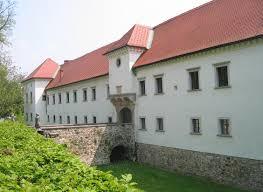Fužinski grad stoji na levem bregu Ljubljanice, na vzhodnem obrobju slovenske prestolnice. Gre za eno najstarejših stavb pri nas, nastalih zaradi razvoja obrti in trgovin v vecje industrijske objekte. Grad, ustrezneje bi mu rekli dvorec, je znacilna renesancna kastelna stavba s stolpi na vogalih. Na breg, ob brzice Ljubljanice, so jo postavili po letu 1528; dvorec sta do leta 1557 zgradila stavbenika Crt in Janez Weilheimer. Njegovi lastniki so bili iz rodbine Khisl – njihovo lastnino so kamnoseki oznacili z grbom nad glavnim vhodom. Po izgonu protestantov, ki so jih Khisli podpirali, so bili do jožefinskih reform v stavbi jezuiti. Dvorec je leta 1825 kupil trgovec in tovarnar Fidelis Terpinc, ki se mu je v Glosi posmehoval sam France Prešeren. Pred stavbo so v 19. stoletju uredili park, ki je segal vzdolž Ljubljanice proti Studencu; v parku je stal spominski steber, posvecen Fidelisu in Josipini Terpinc (1875). Okoli stavbe s tlorisom podaljšanega pravokotnika so v obdobju renesanse izkopali vodni jarek. Še danes podolgovato notranje dvorišce z ostanki vodnjaka oklepajo cokati nadstropni trakti. V ospredju sta stolpast konzolni pomol nad glavnim vhodom in kamnit most cez jarek.
V gradu sta vidni renesancna zasnova in obnovljena, delno poslikana kapela nad glavnim vhodom. Ostanke slikanih dekoracij so predstavili na obhodnem hodniku in na podbojih posameznih vrat v nadstropju ter v severozahodnem stolpu.
Notranje dvorišce bogatijo rekonstruirane arkade in bifore v nadstropju. Likovni poudarki 19. stoletja so izraziti predvsem na stopnišcu v severozahodnem stolpu. Iz zapisov obiskovalcev je znano, da je bila oprema bogata, vendar pa so jo lastniki in najemniki v preteklem stoletju raznesli do zadnjega kosa. Dvorec je bil spremenjen v stanovanja za reveže. Vzhodno polovico gradu so do marca 1992 izpraznili in prenovili za Plecnikovo zbirko Arhitekturnega muzeja; avtor prenove je bil arhitekt Peter Gabrijelcic. Muzej kontinuirano ureja preostale grajske prostore; severni trakt so odprli leta 1994.
S prenovo so zaživele izvirne bifore v arkadiranem nadstropju. Kustosi s sodelavci nacrtujejo pregled razvoja arhitekture na Slovenskem. V pritlicnih dvoranah pripravljajo priložnostne razstave, pripravljen je nacrt rekonstrukcije dela grajskega parka; dvorec Fužine je celo tehniški spomenik. Tik ob utrdbi so leta 1736 ob skalnih brzicah izkopali plovni kanal. Za vevško papirnico so leta 1896 ob zgradbi in v njej uredili hidroelektrarno, prvo vecjo v Sloveniji; podrli so stare mline in izrabili padec Ljubljanice na brzicah. Kasneje so reko zajezili z vecjo betonsko pregrado. Na desnem bregu so postavili posebno stavbo za elektrarno; slednja je z originalno opremo delovala do osemdesetih let, takrat pa so opremo zaceli zamenjevati.
Cache je skrit v parku pred gradom.


Fužine Castle is located on the left bank of the Ljubljanica, at the eastern edge of the Slovene capital city. It is one of the oldest buildings here and was built as a result of the development of crafts and trade into large industrial plants. The castle – better described as a mansion – is a typical Renaissance castle with towers at the corners. It was constructed in 1528 by the masons Crt and Janez Weilheimer on the bank and near the cascades of the Ljubljanica. It was owned by the Khisl family and the property is marked with the family coat-of-arms above the main entrance. After the expulsion of the Protestants from the land – the Khisls had been their benefactors – the Jesuits occupied the building until the reforms of Emperor Joseph II. In 1825 the mansion was purchased by the merchant and industrialist Fidelis Terpinc, whom France Prešeren mocked in his poem “Glosa”. In the 19th century a park was arranged in front of the building, which stretched along the Ljubljanica in the direction of Studenec. A memorial pillar dedicated to Fidelis and Josipina Terpinc stood in the park (1875). During the Renaissance period, a moat was dug around the rectangular building. The elongated inner courtyard with the remains of a well is still surrounded with massive several-storey wings. The main facade is marked with a turret above the main entrance and a stone bridge across the moat.
The Renaissance structure of the castle is still preserved along with a restored chapel above the main entrance, which is partially decorated with murals. The remains of murals are presented in the corridor and on lintels of individual doors on the first floor and in the north-western tower. The inner courtyard is embellished with reconstructed arcades and two-light windows on the first floor. The 19th century artistic elements are evident particularly in the staircase of the north-western tower. Notes made by visitors make it clear that the building was lavishly furnished, but every last piece of furniture was carried off by its owners and renters during the 20th century. The mansion was converted into apartments for the poor. In March 1992 the eastern half of the castle was emptied and renovated to accommodate the museum's Plecnik collection. The renovation was planned by architect Peter Gabrijelcic. The museum is continuing to renovate the rest of the premises. The northern wing was opened to the public in 1994.
During the renovation, the original two-light windows in the arcades on the first floor were exposed. The curators and their associates created a display on the development of architecture in Slovenia. On the ground floor occasional exhibitions are organised and a partial reconstruction of the castle park is planned. Moreover, Fužine Castle is also a technical monument. Next to the building, a navigable channel was dug past the rocky cascades in 1736. The first major hydroelectric plant in Slovenia was set up next to and in the building in 1896 to serve the Vevce paper mill. For this purpose, old mills were pulled down and the natural cascading current of the Ljubljanica was employed. Later, the river was dammed with a large concrete barrier. A separate power plant was constructed on the right bank, which operated until the 1980s when the equipment began to be replaced. The ground floor of the castle accommodates offices and a small restaurant.
Small-size cache is in the park of the castle.